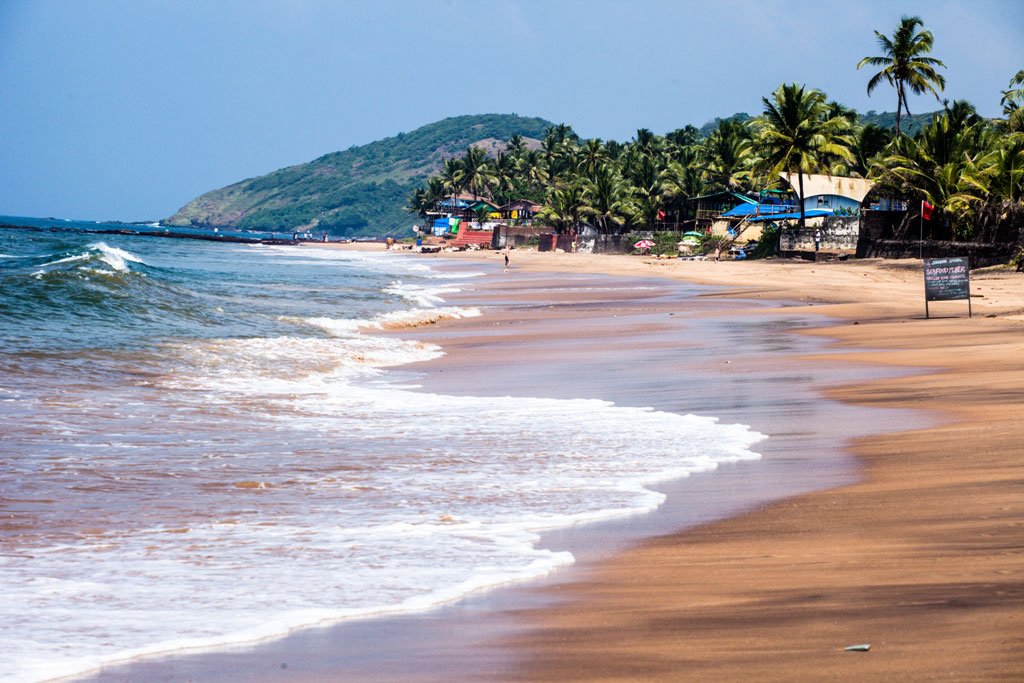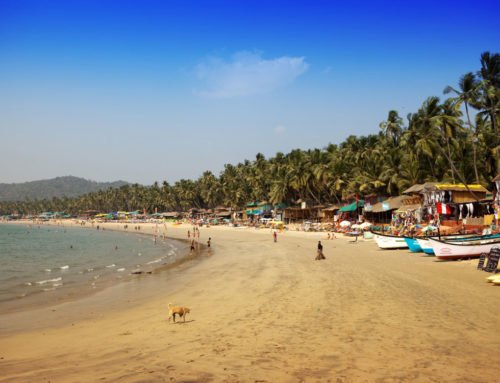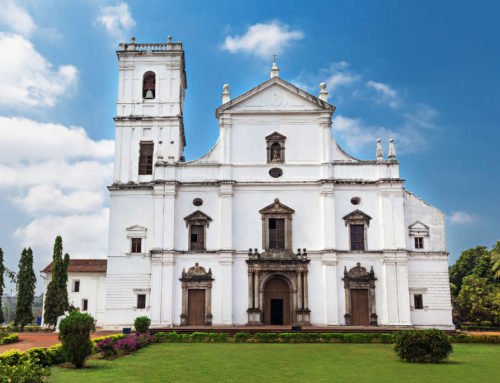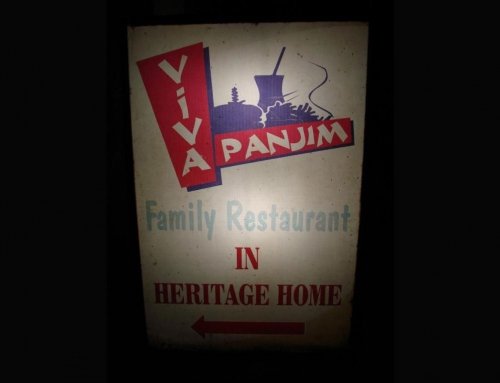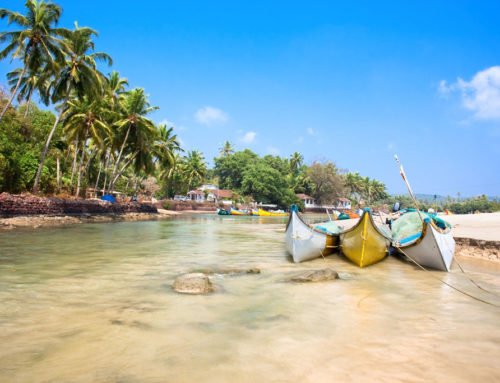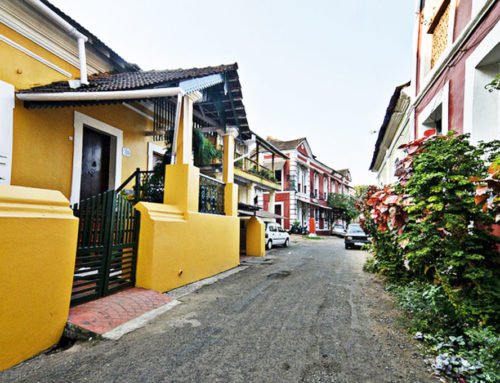Overview
- Main Attractions: Old Goa, Panaji, North and South Goa beaches
- Best Time to Visit: Late October to early March
- Local Specialty: Beaches
- Travelled By: Train, bus, auto rickshaw
- Cost: $$
- Duration of Stay: 4 days
- Location: Goa, India
Author Reviews[display_rating_item_results rating_form_id=”4″ rating_entry_ids=”1″ show_category_filter=”false” show_options=”true” result_type=”star_rating” preserve_max_rating=”true” show_title=”false” show_count=”false” ]
Total Rating: [display_rating_result rating_form_id=”4″ show_count=”false” show_rich_snippets=true] [accordions load=”1″] [accordion title=”User Reviews” last] [display_rating_item_results rating_form_id=”5″ show_options=”true” result_type=”star_rating” preserve_max_rating=”true” show_title=”false” show_count=”true” show_rich_snippets=true] [/accordion] [accordion title=”Add Review”][display_rating_form show_email_input=”true” show_comment_textarea=”true” show_name_input=”true” rating_form_id=”5″] [/accordion] [/accordions]
Summary
Goa is one of India’s most popular tourist destinations and we got to see why. In Old Goa and Panaji we saw the Portuguese influences on Goa’s architecture, culture, food and way of life. However, it was the beaches that stole our breath away. The beaches in South Goa are picture perfect – beaches lined with pristine white sand, coconut trees, cocohuts and colourful beach shacks. It’s like heaven on earth.
Goa: Our Experience
30th November 2013 (Day 1)
We caught our train to Goa in the morning at a crazy 6:30 am. The train arrived more than 30 minutes late which is not too bad for Indian standards. We arrived at Madgaon railway station at 3:00 pm that day, an hour late.
We decided to catch a bus to the local bus depot from where we got an express bus to Panajim, now known as Panaji. From the bus depot in Panaji, we took an auto rickshaw the short distance to our hotel, Palaccio de Goa in St Inex. After a much needed shower, we headed out to see the attractions in Panaji.
[singlepic id=4273 w=720 h=560 float=center]
Our first stop was at the Our Lady of the Immaculate Conception Church which sits like a fairy tale castle atop a hill overlooking Largo da Igreja or “Church Square”, the main square in Panaji. This church is the town’s most important landmark. Its most striking feature is the double flights of stairs leading up to the church.
Since it was leading up to Christmas, there were Christmas carols being such by local children on the steps. The atmosphere was lively and beautiful.
[singlepic id=4274 w=720 h=560 float=center]
To get a feel for the Portuguese influence on this town, we decided to take a walking tour around the Old Town of Panaji. It was a perfect way to get an introduction to what this town was about and the influence the Portuguese had on it in terms of architecture and culture. For over an hour, we walked through the districts of Fontainhas and São Tomé, wandering through terraced hills, cobbled stones, churches and old mansions.
[singlepic id=4275 w=720 h=560 float=center]
After our walking tour of Old Town Panaji, we made our way to the Santa Monica jetty to take a sunset Mandovi River cruise organised by the Goa Tourism Development Corporation (GTDC). It was a great way to see the backwaters of Goa and enjoy some traditional Goan cultural singing and dancing.
[singlepic id=4276 w=720 h=560 float=center]
It was nearly 7:00 pm and walking around had made us tired and hungry, so we made our way to a restaurant that I was really looking forward to eating at – The Upper House. Goan cuisine is one of my favourite Indian cuisines. It is largely influenced by Portuguese flavours and tastes so it is very different to most Indian cuisines. As a child, I grew up eating Goan dishes cooked by my mum and other family members who also love Goan food.
[singlepic id=4258 w=720 h=560 float=center]
After dinner we stopped at a local bottle shop to pick up some chilled beers which we took down to the jetty on the banks of the Mandovi river. The views from the Santa Monica jetty were spectacular – several cruise boats lit up like Christmas trees jostled for prime position at the jetty, and couples holding hands, taking a late night stroll. It was humid and still and the beers were having a soothing effect on our heated senses. It was a lovely way to end the day and an introduction to the next three days in Goa.
1st December 2013 (Day 2)
[singlepic id=4261 w=720 h=560 float=center]
We started the day with a delicious breakfast provided by our hotel in the breakfast area out the back. This was a nice space with umbrellas over each table and a buffet breakfast set up for us to help ourselves. There was a mixture of Indian and Western breakfasts available so we helped ourselves to both to compare the two.
Our Indian breakfast consisted of aloo parathas which are my favourite as well as upma, sambar and dahi which is a traditional South Indian breakfast dish. The Western breakfast consisted of omelettes with white bread. Of course, the Indian breakfast tasted better and had a better variety of dishes so we filled up on this.
[singlepic id=4277 w=720 h=560 float=center]
After breakfast, we made our way to Old Goa, famous for its Portuguese-built churches and cathedrals. We walked to the bus depot a few minutes from the hotel and we were on a bus to Old Goa 30 minutes away.
Being a Sunday the streets were packed with church goers dressed in their Sunday best. There were also local Sunday markets that lined the sides of the streets.
[singlepic id=4278 w=720 h=560 float=center]
Our first stop in Old Goa was Se Cathedral, the largest church in India and Asia. Portuguese churches, and, as a result, the churches in Old Goa, are well-known for their reredos (altar panels) which are strikingly beautiful. This was one of our favourite churches/cathedrals in Old Goa because the reredos here is simply stunning. The cathedral is dedicated to St Catherine of Alexandria and there are as many as 15 altars that grace the interior. However, the pièce-de-résistance is the gilded high altar with panel paintings depicting scenes from the life of St Catherine of Alexandria.
[singlepic id=4279 w=720 h=560 float=center]
The next stop was St Francis of Assisi Church located next door to Se Cathedral. Built in 1521 and then rebuilt in 1661, it was easy to see how ancient these churches are as we walked around their interiors.
This is another gorgeous church filled with gilded and carved woodwork, murals depicting the life of St Francis, frescoes of decorative flowers and various angels, 16th century Portuguese tombstones, and another stunning reredos.
While there was no mass being held at Se Cathedral, there was a small mass being held in the St Francis of Assisi Church.
[singlepic id=4280 w=720 h=560 float=center]
We headed over to the Basilica of Bom Jesus which is the most popular of all the churches in Old Goa. This church derives its popularity from the remains of St Francis Xavier which is held in a tomb inside the church. The feast of St Francis Xavier is held on 3rd December, two days away so there was an extremely long line of local people waiting to kiss the tomb of Goa’s patron saint. After a long wait in the hot sun, we got a chance to see this magnificent basilica.
The basilica is absolutely gorgeous inside with its grand Baroque architectural style blended with other composite styles in its magnificent three-tiered facade. The tomb of St Francis Xavier is beautiful yet austere. As a Roman Catholic myself, it was a privilege and honour to be able to pay my homage to the saint right before his feast.
[singlepic id=4269 w=720 h=560 float=center]
It was early afternoon by the time we exited the basilica so we headed into the markets of Old Goa. Being a Sunday, the markets were packed with people celebrating their Sunday afternoon shopping. The street bazaars were selling everything from traditional Goan food, such as Goan sausages (which I must admit are lip-smacking delicious!) to religious statues and posters. The atmosphere at the market was stellar and there is no better way to enjoy Old Goa than on a Sunday.
[singlepic id=4266 w=720 h=560 float=center]
We had a quick lunch from the bazaar and walked around the streets aimlessly for a little while. There were some nice parks and gardens interspersed between the churches and markets, and people had brought their picnics to lunch with their families in the parks. It was lovely to see the grown ups sitting and chatting while the kids played badminton and other games.
We made our way to the Museum of Christian Art but unfortunately it was closed. They are open every other day of the week.
Nearby were the ruins of the Augustine monastery which had collapsed after the Jesuits left Old Goa and moved their headquarters to Panaji following a series of epidemics that hit Old Goa in the mid-18th century.
[singlepic id=4281 w=720 h=560 float=center]
It was late afternoon which was the perfect time to take a bus to Calangute Beach. We hopped on a bus which took us straight to Calangute. 45 minutes later we were walking down the beach which was crowded with young Indian bachelors throwing each other into the water. There were also some Western tourists mingled in with the Indian tourists but it was one crazy beach. It shouldn’t have been a surprise to us given that Calangute Beach is the most popular beach in Goa.
In addition to the sunbathers, there were masseurs, hair braiders and vendors selling everything someone would want at the beach and more. The entire stretch of the sand was lined with resorts, trinket stalls, bars and beach shacks. As we walked along the beach we watched people frolicking in the water while others soaked up the sun from their beach chairs. Loud music wafted from the cocohuts and beach shacks that lined the beach.
[singlepic id=4282 w=720 h=560 float=center]
The atmosphere was definetely lively but given the several young Indian men around, I didn’t feel comfortable stripping down into my bathers (bikinis). So we walked along the beach fully clothed and made our way to Baga Beach. An extension of Calangute, Baga is probably more sterile and less crowded than its sister beach. There were a lot of water sports activities everywhere with jet skis patrolling the water and people dangling from balloons hitched up to boats.
We headed back to Calangute beach where we had a coconut water at the beach and relaxed for a while before catching a bus back to Panaji. On arrival at Panaji, we walked back to our hotel for a nice cold shower and a short rest.
[singlepic id=4283 w=720 h=560 float=center]
In the evening, we made our way to another Goan restaurant located on a little side street on 31st January Street in Old Town Panaji – Viva Panjim. It’s a lovely little restaurant that caters to the tourist crowd. Apart from the mouth-watering Goan dishes, what I loved about this restaurant were the chairs and tables situated in front of the restaurant that created a laid-back atmosphere that Goa is so well known for. It also allowed us to get a close look at the azulejos (colourful tiles) which is one of Goa’s signature architectural styles. It was also a nice way to end a long, tiring and wonderful day in Goa.
2nd December 2013 (Day 3)
[singlepic id=4270 w=720 h=560 float=center]
A hearty breakfast at 8:00 am was a nice way to start the morning in Goa. Since I loved the Indian breakfast the day before, I had the Indian breakfast again and skipped the Western one. Puris and a vegetable curry was served and it was delicious. Graham had a couple of boiled eggs washed down with a masala chai.
After breakfast, we checked out of our hotel and took a couple of buses to get to Batelbatum in South Goa, where we were staying at Sam’s Comfort. This place is in the middle of nowhere and only a stone’s throw from a secluded beach. It was heaven on earth and we were excited to be here. This place was so different to the Calangute and Baga beaches we had been to the day before. It was smack bang in the middle of a village with tall coconut trees all around us.
You’d think we would just drop at the beach and do nothing, but no. After a shower, we hired a scooter and took it for a ride along the coast stopping at all the Goa beaches along the way.
[singlepic id=4259 w=720 h=560 float=center]
Immediately south of Benaulim, we hit the beach resorts of Varca and Cavelossim with wide, pristine sandy beaches. Just beyond Cavelossim, at the end of the peninsula, we found one of the most picturesque spots in Goa, with simple beach shacks.
[singlepic id=4257 w=720 h=560 float=center]
[singlepic id=4268 w=720 h=560 float=center]
[singlepic id=4263 w=720 h=560 float=center]
As we rode on past Cavelossim, we came upon this charming fishing village called Betul. From Betul on south to Agonda, the road wound over gorgeous, undulating hills thick with palm groves.
Along the way we came upon a stack of tiny fishes out to dry in the sun by the side of the road. Dried fish plays a pivotal role in Goan cuisine and makes for a delicious sauce.
[singlepic id=4262 w=720 h=560 float=center]
[singlepic id=4272 w=720 h=560 float=center]
We stopped at Cabo da Rama, a bleak, old Portuguese fort which had stupendous views of the coast from atop the hill. From there, we drove past Agonda to the south.
[singlepic id=4284 w=720 h=560 float=center]
Finally, just before the sun was about to set we made it to our final destination – Palolem beach. It was a long ride on our little scooter but was it worth it – hell yes!! In our humble opinions, Palolem is one of the most spectacular beaches in Goa by far. It is a picture postcard and everything you dream of when you think of Goa beaches.
The crescent-shaped beach offers dolphin watching trip and tree houses for rent but we were there for another reason – to watch the sun set over Palolem beach and its water. The sunset views here are spectacular and worth stopping everything for. The beach was beautiful with its cocohut restaurants and colourful beach villas which dotted the edge of the beach. As the sun set, we stripped and headed straight for the water which was lovely and warm.
[singlepic id=4285 w=720 h=560 float=center]
After a nice, refreshing swim in the ocean, we walked down the beach in search of our next dinner reservation at one of the Palolem restaurants on the beach. We hit a place called Big Bamboo, and after checking out their catch for the day and spotting a tuna that we liked, we decided to sit at one of their tables on the beach and wait for our tuna steaks grilled to medium rare with chips and salad. With a big jug of cold Kingfisher beer, we watched as the last rays of the sun dipped beyond the horizon. Goa was growing on us and we wished that we had allocated more than four days to this ‘heaven-on-earth’ place.
After dinner Graham rode us back to Betalbatum which was one hairy ride on the narrow roads of South Goa that I will never forget. I honestly thought that it was my last day on earth as there were buses that were overtaking us at full speed on a single stretch of road. Several times Graham had to screech to a halt in order to stop going off the road. Luckily, we made it back in one piece, just in time to hand the keys back to the owner and head straight for bed tired and exhausted, but thoroughly satisfied.
3rd December 2013 (Day 4)
We were getting used to these scrumptious breakfasts being served to us in the mornings. This morning we were surprised with a Western breakfast just as we would have had back home. We were asked how we would like to eat our eggs so we decided to have a cheesy omelette with toast. Cooked to perfection, the omelettes were hot, fluffy and the melted cheese tasted wonderful. We washed the eggs down with mango juice which was fast becoming our favourite juice in India. To end our breakfast, we had a fruit salad of pineapple and papaya which was fresh and juicy.
[singlepic id=4256 w=720 h=560 float=center]
This was our last day in Goa so we decided to do nothing at the local beach all day. We had a train to catch in the afternoon so after breakfast, we walked down to the beach to find a handful of, mostly, older Western tourists lazying around on beach chairs. Being off the beaten track we were surprised to see only a few tourists at the beach.
We came upon Anri’s Place, a beach shack which had one of the best deals on the beach so we decided to spend our day there. Their deal – if we spend Rs 500 on food and drinks combined, we could use their beach chairs with umbrellas for free.
[singlepic id=4267 w=720 h=560 float=center]
So after setting up our beach chairs with an umbrella shade, we stripped and headed straight for the water which was still lovely and warm. The beach was not much to look at but decent enough. There was a boat grounded nearby, and later in the day, we could see para-sailing balloons further up along the beach. We spent several hours in the water dodging the waves. Graham tried to ride a few of them and landed up at the beach. We had a lovely, relaxing time in the water and it was a magical, lazy day.
[singlepic id=4271 w=720 h=560 float=center]
Around 1:00 pm, we headed out of the water and ordered lunch from the beach shack. We tried their Goan prawn curry with rice and Stuffed mackarel with a side of rice. While they prepared our lunch, we enjoyed a glass of chilled Kingfisher beer on our beach chairs under the beach umbrella as the sun came out in full force.
[singlepic id=4265 w=720 h=560 float=center]
Lunch was delicious and the seafood was fresh and wonderfully cooked. The best part was the sauce used for the dishes. The sauce was spicy, sweet as well as sour which tasted fabulous.
After lunch, we made our way back to our room, showered, checked out, and hired a private car to the train station. We were on a 3:50 pm train to Bangalore, our next pit stop in our 10-week trip around India.
Goa had been fantastic, fabulous and fun. Looking back, I can’t believe that we saw and did so much in only four days, but at least now we know what we liked and what we didn’t. Old Goa and Panaji were awesome and great places to get an introduction to the Portuguese influence on Goa from centuries ago. However, it was the Goan beaches that we were drawn to as is every other soul that visits this place. North Goa was ‘thumbs down’ in our books – it was dirty, over crowded and ugly. South Goa, on the other hand, was beautiful and everything we imagined Goan beaches would be. We’ve decided that we will definitely return to Goa on our next trip to India and just stay in Palolem or one of the other South Goan beaches for sure.


